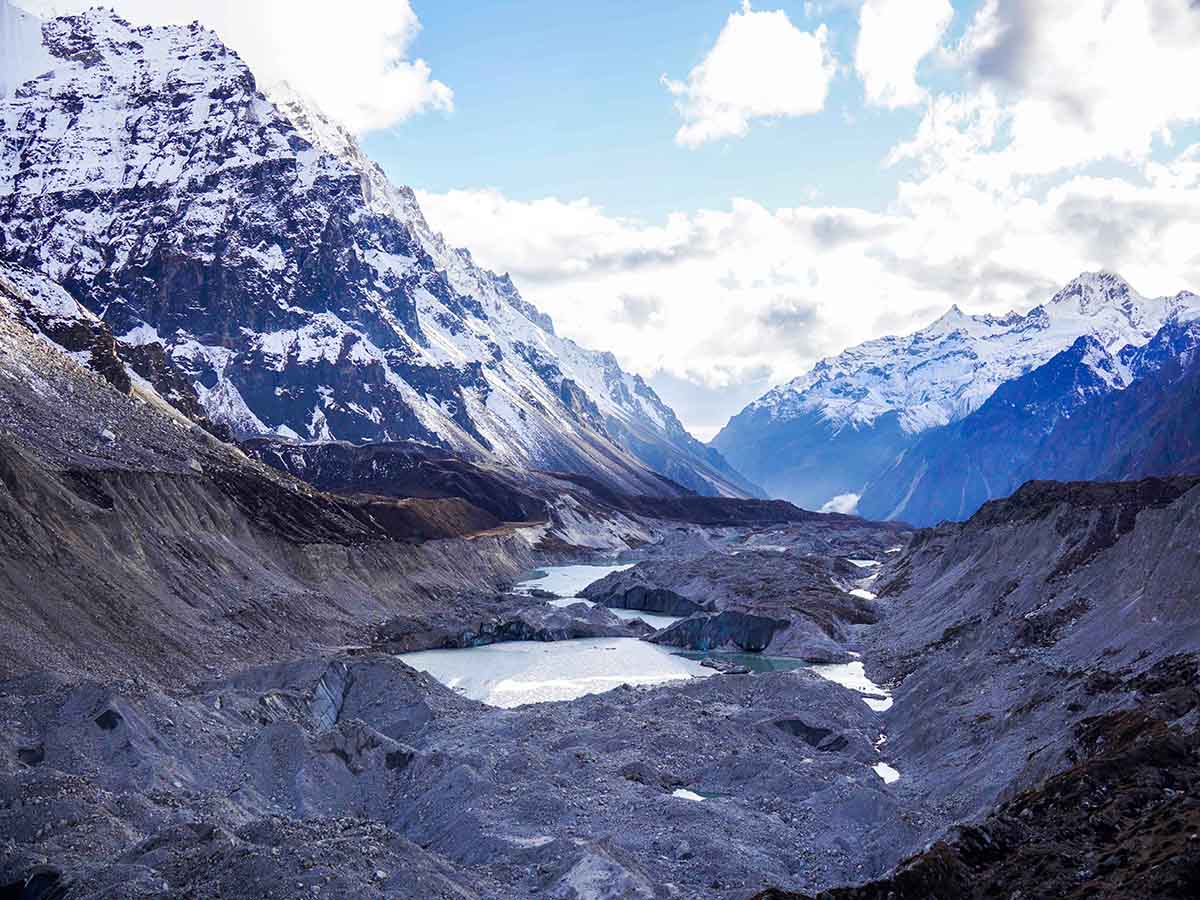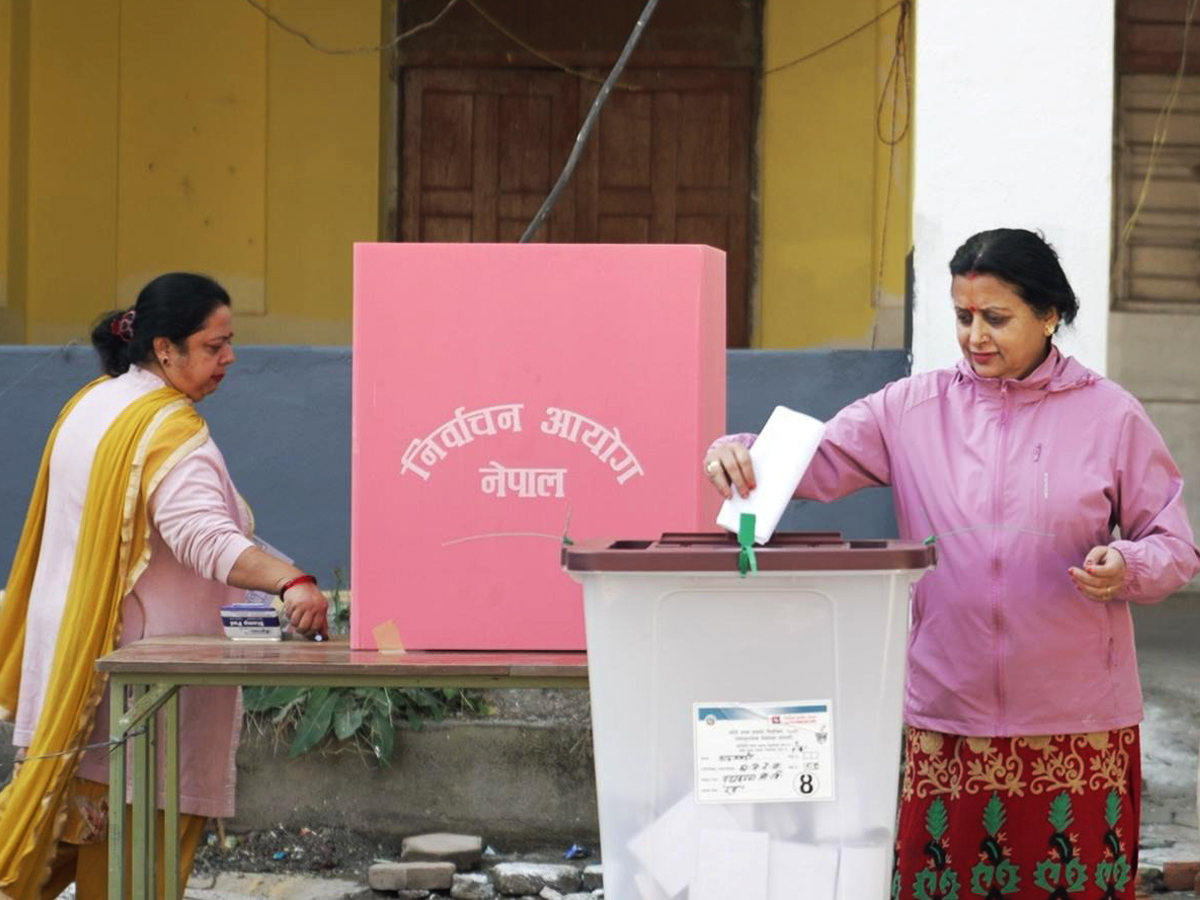Read the story in Nepali: खोलामा सहर : बाढीको बबन्डर
Located right on the banks of the Nakkhu River in Lalitpur district, Medicity Hospital boasts state-of-the-art facilities. Scrolling through the hospital's website, one finds a smiling photo of its founding Chairman, Upendra Mahato, alongside his statement: "We are committed to providing world-class healthcare services with the best technology, infrastructure, and human resources in Nepal, so that no Nepali has to go abroad for treatment." Upendra is also the founding president of the Non-Resident Nepali Association (NRNA).
 Despite Upendra's claim of world-class infrastructure, the first floor of this hospital was completely submerged by the floods in the last week of September last year. An institution that offers both ground and air ambulance services found itself in a situation where people had to use boats to enter. This hospital complex occupies land that was once part of the Nakkhu River's flow.
Despite Upendra's claim of world-class infrastructure, the first floor of this hospital was completely submerged by the floods in the last week of September last year. An institution that offers both ground and air ambulance services found itself in a situation where people had to use boats to enter. This hospital complex occupies land that was once part of the Nakkhu River's flow.
This serves as an example that when we encroach upon nature, it doesn't differentiate between the rich and the poor, powerful and helpless, or robust and weak infrastructure. Disaster management expert Gangalal Tuladhar alleges that Medicity Hospital's encroachment on the river led to this situation. "They didn't listen no matter how much we tried to explain," he said.
Last year's floods taught many a crucial lesson: Don't encroach upon rivers. Sooner or later, you will face disaster. That time of reckoning is gradually approaching.
The situation was similar for the Sunrise Apartment building, located near Medicity Hospital, during the September floods. The Lalitpur Metropolitan City Police have compiled data showing that the Nakkhu River directly affected over 300 homes.
Nepal is experiencing rapid urbanization, and with it, construction of houses and other structures along urban rivers and riverbanks has increased. In some places, buildings have even been constructed by encroaching directly on the riverbed. Walls have been built on both sides of the river, narrowing its natural flow.
As a result, natural drainage processes are obstructed, water flow becomes uncontrolled, and floods begin to enter and spread into the city. Settlements along the rivers in Kathmandu Valley experience the effects of this every year, and Medicity faced a similar impact last September.
Upendra, the operator of the flood-affected Medicity Hospital, claims the hospital's structure did not encroach upon the river. "The idea that the hospital encroached on the river is a misconception. The relevant authorities have already measured and investigated this," he stated.
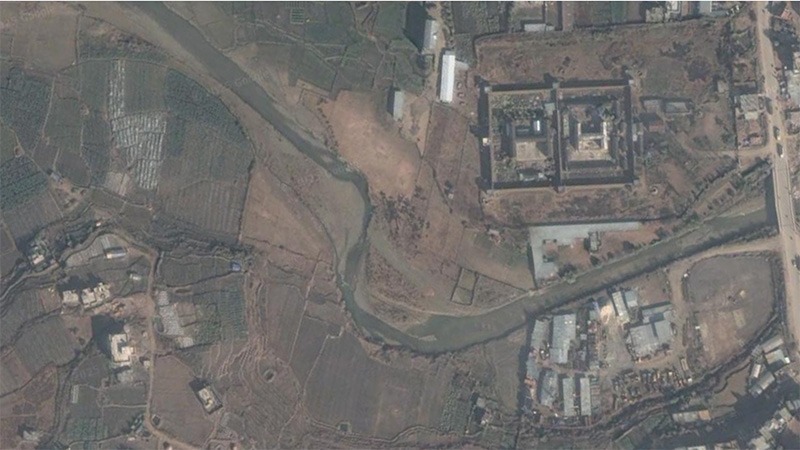
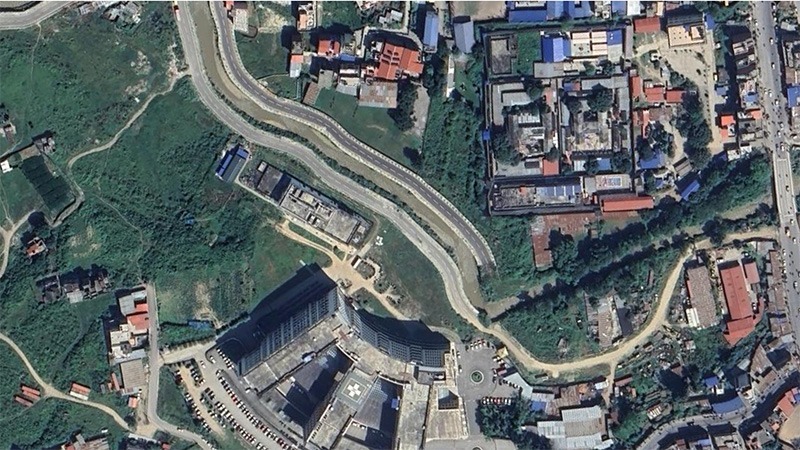
He asserts that the hospital was inundated because water couldn't drain properly due to Manjushree Hill in Chobhar. The Chobhar gorge is the drainage point for all water that falls in the Kathmandu Valley.
"Houses and temporary structures along the riverbanks have altered the river's flow, and there are problems like sand and soil accumulation at the base of the flow," he explained. "When there was a sudden heavy downpour, rocks and sand carried by landslides blocked the water, causing it to enter the hospital's structure." According to Upendra, the flood submerged one floor of Medicity, resulting in damages exceeding NPR 1 billion. The hospital's services were suspended for 10 days after the flood.
To protect settlements and structures along riverbanks from such floods, Upendra suggested that the government should remove soil and construct retaining walls.
Upendra claims that the District Survey Office, Lalitpur, measured and verified that Medicity Hospital is on its own land. However, Ramesh Gyawali, head of the Survey Office, clarified that his agency does not provide such certification. "Our office only handles property verification and map approvals," he said. "The Survey Office does not look into compliance with standards."
Gyawali informed that the authorized body for such matters is the Kathmandu Valley Development Authority. According to the Authority's 2008-2009 standards, a 12-meter setback should be maintained on both sides of the Nakkhu River. However, it was found that these standards were not fully adhered to there.
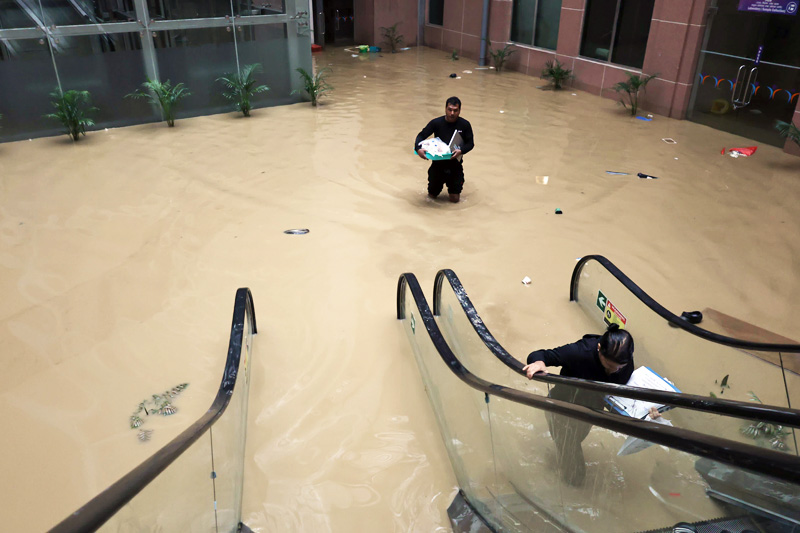
Hospital staff moving essential medicines and documents after the first floor was submerged by the flood. Photo: Saroj Basnet/NIMJN
According to Saurabh Dhakal, Information Officer at the Authority, Medicity Hospital submitted an application for planning permission to construct a 300-bed hospital on March 17, 2013. The hospital's area spans 48 ropani, 9 aana, 3 paisa, and 6 daam, which is registered on its land ownership certificate (lalpurja).
Dhakal stated that the site has since been verified, and the hospital has requested new planning permission for a revised plan to build an additional 700 beds. However, this permission has not yet been granted.
Dhakal explained that the Authority's stance is firm: Permission will not be granted until the hospital complies with the condition to leave the land designated for the Rajkulo (a traditional irrigation canal) within the hospital's premises.
"According to the condition, the Rajkulo land is government-owned land belonging to the Nepal government. Unless they relinquish that land, we cannot grant further planning permission," he said.
Increasing Havoc of Floods
On September 28, 2024, not only did major rivers swell, but even small streams in the Kathmandu Valley experienced flash floods. In Bhachakhosi Stream (near Swayambhu) in Kathmandu Metropolitan City-15, 19-year-old Rajan Shrestha was swept away along with his motorbike.
Rajan, originally from Yamunadanda, Sindhupalchowk, and residing in Nagarjun, Kathmandu-2, was a student at Manaslu College. He had gone to a friend's place to pick up a notebook.
His brother-in-law, Saroj Shrestha, shared that Rajan's parents are now in depression due to the loss of their only son. Rajan's elder sister, Rita Shrestha, is also still grieving the pain of losing her brother to the flood. "Nature inflicted a great wound upon us," Saroj, his brother-in-law, recounted. "My brother, who was preparing for his exams, was swept away by the river along with his bike, and this happened right in the city."
In Lalitpur Metropolitan City-9, Chowkhi Khola, a landslide claimed the life of Abilesh Limbu's mother. "Who can contend with nature?" Abilesh remembers that moment, "My mother, buried in the landslide, couldn't be rescued immediately."
According to her, the incident occurred at 1 am. They had to call people from the church to help retrieve her. "It wasn't a place where you'd expect a landslide; there was a forest above," Abilesh said. "After a lot of rain, as we were moving our belongings and relocating ourselves to a neighbor's house, the landslide buried my mother."
Many others in the Kathmandu Valley also suffered damages from the floods. Sumitra Karki's house in Hattiban, Lalitpur, was inundated. She left her home and moved elsewhere. Goods on the first floor of her house were completely ruined. Her electric car, parked in the compound, developed problems, and repairs cost her over NPR 300,000.
Over the last 12 years, the Kathmandu Valley has experienced 387 water-related incidents (floods, landslides, and heavy rainfall), resulting in 119 deaths. According to the National Disaster Risk Reduction and Management Authority, 914 families were affected, 11 people are missing, and 105 were injured. The total damage amounted to NPR 194,567,500.
The year 2024-2025 saw the most significant damage, with 157 incidents leading to 73 deaths. Six people went missing, 49 were injured, and 410 families were affected.
According to the National Disaster Risk Reduction and Management Authority (NDRRMA), the September floods last year caused approximately NPR 46.68 billion in damages nationwide. Of this, NPR 38.92 billion was in physical infrastructure.
An analysis of the Authority's data reveals that such incidents are increasing each year. The primary reason for this is the overflow of rivers in the valley.
All the experts interviewed in this study share a common sentiment: "The settlements didn't enter the river; rather, settlements were built on the river. Whatever increase we're seeing in flood-related disasters, we humans are the cause. This is a human-made problem. We can protect ourselves from it by improving our own actions."
However, the Authority prefers not to call this a "flood." In response to frequently asked questions (FAQs), the National Disaster Risk Reduction and Management Authority states on its website: "The inundation experienced in Kathmandu and other major cities in recent years is not a flood; in disaster terminology, it is called 'waterlogging.' These problems have arisen due to the natural flow of rivers being obstructed by various structures built in urban areas."
Whether it's a flood or 'waterlogging,' its destructive impact is becoming increasingly rampant. UNICEF Nepal addresses this issue on its website, stating: "In Nepal, it is believed that a disaster can occur at any time. Therefore, in the Nepali context, the question 'when' is more appropriate than 'where' or 'if'."
Who Cares about the Constitution?
Nepal's Constitution, under Article 51, outlines the policies of the state. Specifically, Clause (f) addresses policies concerning the conservation, promotion, and utilization of natural resources. Within this, Sub-clause (4) states, "Controlling water-induced disasters and managing rivers while developing sustainable and reliable irrigation."
The constitution has adopted policies to reduce the risk of natural disasters through early warning, preparedness, rescue, relief, and rehabilitation. Schedule 7 of the constitution places natural and non-natural disaster preparedness, rescue, relief, and recovery efforts under the joint authority of the federal and provincial governments. Similarly, Schedule 8 includes disaster management in the exclusive list of local level powers, while Schedule 9 lists it under the concurrent powers of the federal, provincial, and local levels.
However, observing the encroachment on rivers and streams in the Valley and the increasing disasters, it feels as though none of the three tiers of government have been able to view "controlling water-induced disasters and managing rivers" as mandated by the constitution as their responsibility.
On November 16, 2008, the Council of Ministers decided that no structures could be built within 20 meters of the banks of the Bagmati, Bishnumati, and Manohara rivers. The Supreme Court, on December 19, 2023, further interpreted this, issuing a mandamus order to extend the setback from 20 to 40 meters. When Kathmandu Metropolitan City prepared to implement the Supreme Court's order, it faced strong opposition.
At that time, Kathmandu Metropolitan Mayor Balendra Shah even wrote on Facebook, "When planning, approving maps, conducting real estate transactions, or mortgaging properties in riverine and stream areas, please adhere to the 40-meter standard. Otherwise, you will face consequences later."
However, the federal government itself has gone for a 'vacate' against the Supreme Court's mandamus order, leaving the matter in limbo. The extent of its impact on the general public is a separate issue, but it could help keep the Valley safe from river-induced disasters.
Growing Settlements, Shrinking Rivers
Excessive rainfall, erratic weather patterns, and uneven rainfall distribution due to climate change have intensified incidents of floods and inundation. All these factors have caused significant damage to human lives and physical infrastructure. When water flow is obstructed and there's no way for excess rainwater to drain, flood disasters inevitably occur. This is a direct result of river encroachment.
In urban areas, unplanned urbanization has further exacerbated this risk. According to experts, a long-term plan is essential to address this problem.
Dr. Dharma Upreti, a climate and weather disaster management expert, stated, "Structures built by encroaching on rivers have increased the risk of floods and inundation. We need a long-term plan to resolve this."
The construction of numerous unregulated structures along riverbanks in major urban areas, including the Kathmandu Valley, has severely impeded water flow. This makes water drainage increasingly impossible during the rainy season, drastically elevating the risks of floods.
Homes and commercial structures built in areas like Nakkhu, Gaushala, and other riverine areas of Kathmandu have worsened this situation. When water levels rise, these structures prevent water from draining, leading to flood outbreaks.
Navaraj Pyakurel, Deputy Development Commissioner and urban development expert at the Kathmandu Valley Development Authority, warns, "By building houses and structures along riverbanks, we have failed to understand nature's balance. These structures significantly increase the risk of floods and inundation."
According to Archana Shrestha, Deputy Director at the Department of Hydrology and Meteorology, urban structures have greatly obstructed natural drainage processes. She states, "This increases the risk of floods and inundation."
She cited the flood of last September, which caused extensive damage in the Kathmandu Valley, as an example. This flood highlighted the dangerous impacts of structures along riverbanks. Therefore, it is crucial to give further consideration to improving water flow management.
Precarious Settlements
The future of settlements situated along riverbanks in Nepal's urban areas is precarious. Cities, including those in the Kathmandu Valley, face an escalating risk of floods and inundation. This risk cannot be mitigated until unplanned urbanization and structures along riverbanks are improved.
Archana Shrestha, Deputy Director at the Department of Hydrology and Meteorology, stresses the urgent need to address the future of homes and structures located on riverbanks. "Due to climate change, we require significant changes in urban infrastructure. We must allow water to flow naturally. Riverbanks should be left open and unobstructed," she stated. She suggests that the state should consider alternatives for riverbank settlements.
According to her, if we improve structures along riverbanks and facilitate water flow, the risk of floods and inundation can be significantly reduced.
Dr. Dharma, a climate and weather disaster management expert, adds to this, stating, "Structures on riverbanks must be removed, and new structures should be built according to standards." He recommends that local bodies prioritize river cleaning efforts and emphasizes the necessity of integrating climate change and urbanization into long-term planning.
When Rivers Rage
According to the National Strategy for Disaster Risk Reduction (NSDRR) 2018-2030, Nepal boasts over 6,000 rivers, both large and small, with a combined length of approximately 45,000 kilometers.
These rivers are vital for providing agricultural irrigation and supporting livelihoods. However, the NSDRR also notes that when these rivers flood, they primarily cause widespread devastation in the Terai plains and valleys.
The Tenth Five-Year Plan (2002-2007) adopted disaster management as an interconnected policy. This plan emphasized controlling water-induced disasters, integrated management of natural and human-made disasters, policy reform, institutional mechanism development, disaster risk assessment and information dissemination, and the practice of disaster-resilient construction.
The Three-Year Interim Plan (2007-2010) recognized disasters as an impediment to achieving development goals and accepted that disaster risk reduction was essential for sustainable development. This plan stressed cooperation and coordination among key agencies and stakeholders. Furthermore, the Fourteenth Plan (2016-2019) prioritized disaster management, adopting a policy to conduct special programs for capacity building in emergency search, rescue, treatment, and immediate relief, and to mainstream disaster risk reduction into all dimensions and stages of development.
Solution: Change the Structures
Due to climate change, rainfall and water distribution have become uneven, posing a significant challenge to drainage systems. According to departmental expert Archana Shrestha, rainwater harvesting and groundwater recharge systems can help solve this problem. These systems collect water, raise groundwater levels, and improve natural water flow.
"The practice of rainwater harvesting helps reduce water scarcity by collecting rainwater, which in turn supports groundwater recharge systems and lowers the risk of floods and inundation," says Archana. "To make this effective, the construction of rainwater harvesting structures in urban areas is essential."
She believes that structural improvements and the proper use of rainwater harvesting systems in urban areas allow water to flow naturally, thereby reducing the risk of floods. Archana states that the way to avoid this is to improve structures along riverbanks and ensure they do not obstruct water flow.
Dr. Dharma, a climate and weather disaster management expert, shares a similar view. "In addition to improving unplanned urbanization and structures built on riverbanks, the use of rainwater harvesting and groundwater recharge systems is extremely important," he said. "Through these, the drainage process can be eased, and we can reduce the risks of floods."
According to Chandralal Maharjan, Coordinator of the Lalitpur Metropolitan City Infrastructure Development Committee, houses and roads built in various parts of the city still violate standards. "Today, we went for monitoring and saw houses and roads built by encroaching on rivers, in particular. It is extremely necessary to improve our human habits," he stated.
Urban development expert Padmasundar Joshi considers the lack of planned development in urban areas to be the main problem when rivers enter cities and cause inundation. "Our political leadership does not want to move forward with planned development," he said. "The day they are ready for this, development will be possible, and we can avoid inundation."
According to Padmasundar, if a major flood occurs, more than half of Kathmandu will be submerged. "We make plans, but we don't act on them," he says, "We shouldn't delay any longer."
Geologist Dr. Ranjan Dahal has warned about the problems arising from unplanned urbanization along riverbanks. Stating that settling on riverbanks is a mistake, he said, "In Kapan, Kathmandu, the river itself has disappeared due to roads and settlements. Our major problem is building structures that occupy the river."
Dahal also emphasized the need to remove sand from the confluence of the Manohara and Bagmati rivers up to Chobhar. "River cleaning and measures for water recharge should be adopted," he said.
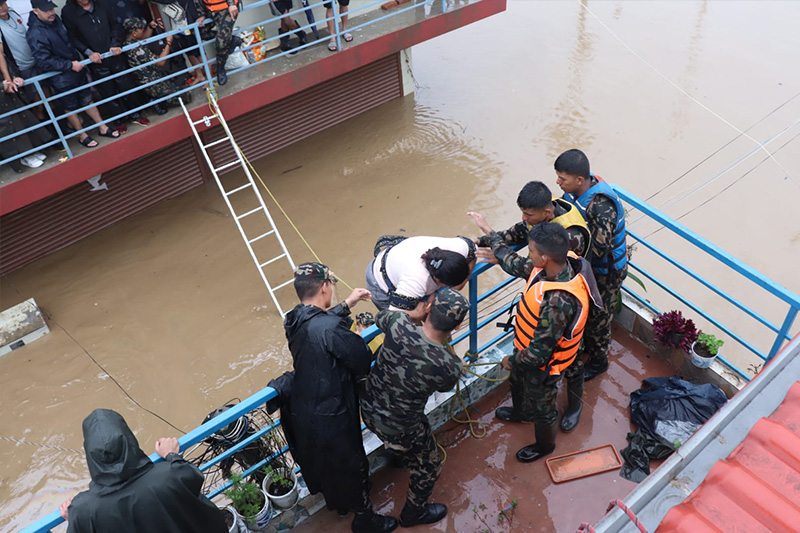
To avert floods and inundation, a long-term plan is crucial, emphasizing adherence to standards for riverbank structures and planned construction. For this, the federal government and local bodies must collaborate to take strict measures for the protection of river areas. Urban development expert Navaraj Pyakurel suggests, "Rainwater harvesting, river cleaning, and ensuring structural standards are foolproof measures that can help reduce the risk of floods and inundation."
According to Rajendra Sharma, Under Secretary at the National Disaster Risk Reduction and Management Authority, mapping every location concerning climate and water volume is necessary. "We haven't been able to map all locations yet," he states. "Every house and neighborhood should be mapped so we can understand the type of clouds, amount of rain, and potential extent of damage."
Sharma also emphasizes the need to use tools like smart sirens and involve local bodies in these efforts. "Unplanned urbanization and haphazard plotting have increased the risk of floods and landslides," he noted. "Building structures with proper planning and in appropriate locations can reduce the risk."
Dr. Suman Narsingh Rajbhandari, Vice-Chair of the Kathmandu Metropolitan City Planning Commission, stresses the importance of research and planning. He believes that long-term solutions for river and flood-related disasters in Kathmandu require initial research. "Until we identify the main causes of floods and inundation, solving this problem will be difficult," he says. According to him, research and planned improvements are essential for urban development.
Dr. Dharma, a climate and weather disaster management expert, also advocates for a long-term plan. He states that unplanned urbanization and the construction of settlements on riverbanks have intensified the risk of loss of life and property, as well as flood outbreaks. To address this problem, a long-term plan is necessary. "This should involve advancing urbanization while considering the impacts of climate change and improving structures along riverbanks," he says. "If we don't do this, we will have to endure even greater flood and inundation disasters in the future."
KVDA, a Silent Spectator
Bringing those who violate standards during construction under the ambit of legal action is the primary responsibility of the Kathmandu Valley Development Authority. However, in reality, the Authority appears to be inactive in this matter. Information Officer Saurabh himself has acknowledged this. He stated that while other local bodies, including the Survey Office and Land Revenue Office, also have a role, the main responsibility for monitoring and taking action lies with the Authority.
"Extensive monitoring is necessary, but currently, due to a lack of manpower, regular monitoring hasn't been possible," he explained. According to Saurabh, Section 8 of the Kathmandu Valley Development Authority Act (1988) clearly stipulates action against those who violate standards.
In 2021-2022, despite Bhaktapur and Lalitpur districts issuing notices against structures built contrary to standards, they haven't been able to take action. Notices were published in newspapers stating that standards were violated in 73 locations in Lalitpur and 80 locations in Bhaktapur. However, he confirmed that no action has been taken.
The Law Grants Authority
According to Section 8, if any activities regularly controlled or prohibited by the Kathmandu Valley Development Authority are carried out without approval, the Authority can immediately order those activities to cease.
If such activities involve construction, the Authority can issue an order to the concerned individual, providing a 35-day deadline to demolish or remove parts constructed without approval or in violation of conditions.
Similarly, if any individual acts without the Authority's prior approval or contrary to specified conditions, the Act stipulates that the Authority can impose a fine of up to NPR 50,000.
Cover photo: Medicity Hospital submerged in the flood of September 28, 2024. Photo: Saroj Basnet/NIMJN
Please adhere to our republishing policy if you'd like to republish this story. You can find the guidelines here.


